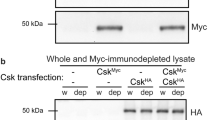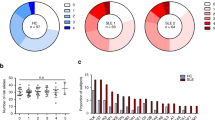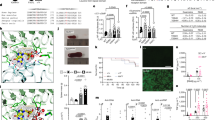Abstract
The B-lymphocyte kinase (BLK) gene is associated genetically with several human autoimmune diseases including systemic lupus erythematosus. We recently described that the genetic risk is given by two haplotypes: one covering several strongly linked single-nucleotide polymorphisms within the promoter of the gene that correlated with low transcript levels, and a second haplotype that includes a rare nonsynonymous variant (Ala71Thr). Here we show that this variant, located within the BLK SH3 domain, is a major determinant of protein levels. In vitro analyses show that the 71Thr isoform is hyperphosphorylated and promotes kinase activation. As a consequence, BLK is ubiquitinated, its proteasomal degradation enhanced and the average life of the protein is reduced by half. Altogether, these findings suggest that an intrinsic autoregulatory mechanism previously unappreciated in BLK is disrupted by the 71Thr substitution. Because the SH3 domain is also involved in protein interactions, we sought for differences between the two isoforms in trafficking and binding to protein partners. We found that binding of the 71Thr variant to the adaptor protein BANK1 is severely reduced. Our study provides new insights on the intrinsic regulation of BLK activation and highlights the dominant role of its SH3 domain in BANK1 binding.
This is a preview of subscription content, access via your institution
Access options
Subscribe to this journal
Receive 6 digital issues and online access to articles
$119.00 per year
only $19.83 per issue
Buy this article
- Purchase on Springer Link
- Instant access to full article PDF
Prices may be subject to local taxes which are calculated during checkout






Similar content being viewed by others
References
Tretter T, Ross AE, Dordai DI, Desiderio S . Mimicry of pre-B cell receptor signaling by activation of the tyrosine kinase Blk. J Exp Med 2003; 198: 1863–1873.
Akerblad P, Sigvardsson M . Early B cell factor is an activator of the B lymphoid kinase promoter in early B cell development. J Immunol 1999; 163: 5453–5461.
Simpfendorfer KR, Olsson LM, Manjarrez Orduno N, Khalili H, Simeone AM, Katz MS et al. The autoimmunity-associated BLK haplotype exhibits cis-regulatory effects on mRNA and protein expression that are prominently observed in B cells early in development. Hum Mol Genet 2012; 21: 3918–3925.
Compeer EB, Janssen W, van Royen-Kerkhof A, van Gijn M, van Montfrans JM, Boes M . Dysfunctional BLK in common variable immunodeficiency perturbs B-cell proliferation and ability to elicit antigen-specific CD4+ T-cell help. Oncotarget 2015; 6: 10759–10771.
Samuelson EM, Laird RM, Maue AC, Rochford R, Hayes SM . Blk haploinsufficiency impairs the development, but enhances the functional responses, of MZ B cells. Immunol Cell Biol 2011; 90: 620–629.
Hom G, Graham RR, Modrek B, Taylor KE, Ortmann W, Garnier S et al. Association of systemic lupus erythematosus with C8orf13-BLK and ITGAM-ITGAX. N Engl J Med 2008; 358: 900–909.
Gateva V, Sandling JK, Hom G, Taylor KE, Chung SA, Sun X et al. A large-scale replication study identifies TNIP1, PRDM1, JAZF1, UHRF1BP1 and IL10 as risk loci for systemic lupus erythematosus. Nat Genet 2009; 41: 1228–1233.
Okada Y, Wu D, Trynka G, Raj T, Terao C, Ikari K et al. Genetics of rheumatoid arthritis contributes to biology and drug discovery. Nature 2014; 506: 376–381.
Gregersen PK, Amos CI, Lee AT, Lu Y, Remmers EF, Kastner DL et al. REL, encoding a member of the NF-kappaB family of transcription factors, is a newly defined risk locus for rheumatoid arthritis. Nat Genet 2009; 41: 820–823.
Freudenberg J, Lee HS, Han BG, Shin HD, Kang YM, Sung YK et al. Genome-wide association study of rheumatoid arthritis in Koreans: population-specific loci as well as overlap with European susceptibility loci. Arthritis Rheum 2011; 63: 884–893.
Deshmukh HA, Maiti AK, Kim-Howard XR, Rojas-Villarraga A, Guthridge JM, Anaya JM et al. Evaluation of 19 autoimmune disease-associated loci with rheumatoid arthritis in a Colombian population: evidence for replication and gene-gene interaction. J Rheumatol 2011; 38: 1866–1870.
Genin E, Coustet B, Allanore Y, Ito I, Teruel M, Constantin A et al. Epistatic interaction between BANK1 and BLK in rheumatoid arthritis: results from a large trans-ethnic meta-analysis. PLoS One 2013; 8: e61044.
Gourh P, Agarwal SK, Martin E, Divecha D, Rueda B, Bunting H et al. Association of the C8orf13-BLK region with systemic sclerosis in North-American and European populations. J Autoimmun 2010; 34: 155–162.
Nordmark G, Kristjansdottir G, Theander E, Appel S, Eriksson P, Vasaitis L et al. Association of EBF1, FAM167A(C8orf13)-BLK and TNFSF4 gene variants with primary Sjogren's syndrome. Genes Immun 2011; 12: 100–109.
Iwata Y, Akamatsu H, Hasegawa S, Takahashi M, Yagami A, Nakata S et al. The epidermal integrin beta-1 and p75NTR positive cells proliferating and migrating during wound healing produce various growth factors, while the expression of p75NTR is decreased in patients with chronic skin ulcers. J Dermatol Sci 2013; 71: 122–129.
Miller FW, Cooper RG, Vencovsky J, Rider LG, Danko K, Wedderburn LR et al. Genome-wide association study of dermatomyositis reveals genetic overlap with other autoimmune disorders. Arthritis Rheum 2013; 65: 3239–3247.
Onouchi Y, Ozaki K, Burns JC, Shimizu C, Terai M, Hamada H et al. A genome-wide association study identifies three new risk loci for Kawasaki disease. Nat Genet 2012; 44: 517–521.
Ge B, Pokholok DK, Kwan T, Grundberg E, Morcos L, Verlaan DJ et al. Global patterns of cis variation in human cells revealed by high-density allelic expression analysis. Nat Genet 2009; 41: 1216–1222.
Delgado-Vega AM, Dozmorov MG, Quiros MB, Wu YY, Martinez-Garcia B, Kozyrev SV et al. Fine mapping and conditional analysis identify a new mutation in the autoimmunity susceptibility gene BLK that leads to reduced half-life of the BLK protein. Ann Rheum Dis 2012; 71: 1219–1226.
Wu YY, Georg I, Diaz-Barreiro A, Varela N, Lauwerys B, Kumar R et al. Concordance of increased B1 cell subset and lupus phenotypes in mice and humans is dependent on BLK expression levels. J Immunol 2015; 194: 5692–5702.
Dymecki SM, Niederhuber JE, Desiderio SV . Specific expression of a tyrosine kinase gene, blk, in B lymphoid cells. Science 1990; 247: 332–336.
Kurosaki T, Hikida M . Tyrosine kinases and their substrates in B lymphocytes. Immunol Rev 2009; 228: 132–148.
Kasahara K, Nakayama Y, Kihara A, Matsuda D, Ikeda K, Kuga T et al. Rapid trafficking of c-Src, a non-palmitoylated Src-family kinase, between the plasma membrane and late endosomes/lysosomes. Exp Cell Res 2007; 313: 2651–2666.
Boggon TJ, Eck MJ . Structure and regulation of Src family kinases. Oncogene 2004; 23: 7918–7927.
Alvarado JJ, Betts L, Moroco JA, Smithgall TE, Yeh JI . Crystal structure of the Src family kinase Hck SH3-SH2 linker regulatory region supports an SH3-dominant activation mechanism. J Biol Chem 2010; 285: 35455–35461.
Abrams CS, Zhao W . SH3 domains specifically regulate kinase activity of expressed Src family proteins. J Biol Chem 1995; 270: 333–339.
Okada M . Regulation of the SRC family kinases by Csk. Int J Biol Sci 2012; 8: 1385–1397.
Bewarder N, Weinrich V, Budde P, Hartmann D, Flaswinkel H, Reth M et al. In vivo and in vitro specificity of protein tyrosine kinases for immunoglobulin G receptor (FcgammaRII) phosphorylation. Mol Cell Biol 1996; 16: 4735–4743.
Saouaf SJ, Kut SA, Fargnoli J, Rowley RB, Bolen JB, Mahajan S . Reconstitution of the B cell antigen receptor signaling components in COS cells. J Biol Chem 1995; 270: 27072–27078.
Pleiman CM, Clark MR, Gauen LK, Winitz S, Coggeshall KM, Johnson GL et al. Mapping of sites on the Src family protein tyrosine kinases p55blk, p59fyn, and p56lyn which interact with the effector molecules phospholipase C-gamma 2, microtubule-associated protein kinase, GTPase-activating protein, and phosphatidylinositol 3-kinase. Mol Cell Biol 1993; 13: 5877–5887.
Bernal-Quiros M, Wu YY, Alarcon-Riquelme ME, Castillejo-Lopez C . BANK1 and BLK act through phospholipase C gamma 2 in B-cell signaling. PLoS One 2013; 8: e59842.
Oda H, Kumar S, Howley PM . Regulation of the Src family tyrosine kinase Blk through E6AP-mediated ubiquitination. Proc Natl Acad Sci USA 1999; 96: 9557–9562.
Kozyrev SV, Abelson AK, Wojcik J, Zaghlool A, Linga Reddy MV, Sanchez E et al. Functional variants in the B-cell gene BANK1 are associated with systemic lupus erythematosus. Nat Genet 2008; 40: 211–216.
Rueda B, Gourh P, Broen J, Agarwal SK, Simeon C, Ortego-Centeno N et al. BANK1 functional variants are associated with susceptibility to diffuse systemic sclerosis in Caucasians. Ann Rheum Dis 2010; 69: 700–705.
Yokoyama K, Su Ih IH, Tezuka T, Yasuda T, Mikoshiba K, Tarakhovsky A et al. BANK regulates BCR-induced calcium mobilization by promoting tyrosine phosphorylation of IP(3) receptor. EMBO J 2002; 21: 83–92.
Castillejo-Lopez C, Delgado-Vega AM, Wojcik J, Kozyrev SV, Thavathiru E, Wu YY et al. Genetic and physical interaction of the B-cell systemic lupus erythematosus-associated genes BANK1 and BLK. Ann Rheum Dis 2012; 71: 136–142.
Friedel CC, Dolken L, Ruzsics Z, Koszinowski UH, Zimmer R . Conserved principles of mammalian transcriptional regulation revealed by RNA half-life. Nucleic Acids Res 2009; 37: e115.
Noble ME, Musacchio A, Saraste M, Courtneidge SA, Wierenga RK . Crystal structure of the SH3 domain in human Fyn; comparison of the three-dimensional structures of SH3 domains in tyrosine kinases and spectrin. EMBO J 1993; 12: 2617–2624.
Kelley LA, Mezulis S, Yates CM, Wass MN, Sternberg MJE . The Phyre2 web portal for protein modeling, prediction and analysis. Nat Protocols 2015; 10: 845–858.
Sato I, Obata Y, Kasahara K, Nakayama Y, Fukumoto Y, Yamasaki T et al. Differential trafficking of Src, Lyn, Yes and Fyn is specified by the state of palmitoylation in the SH4 domain. J Cell Sci 2009; 122: 965–975.
McCabe JB, Berthiaume LG . Functional roles for fatty acylated amino-terminal domains in subcellular localization. Mol Biol Cell 1999; 10: 3771–3786.
Obata Y, Fukumoto Y, Nakayama Y, Kuga T, Dohmae N, Yamaguchi N . The Lyn kinase C-lobe mediates Golgi export of Lyn through conformation-dependent ACSL3 association. J Cell Sci 2010; 123: 2649–2662.
Ikeda K, Nakayama Y, Ishii M, Obata Y, Kasahara K, Fukumoto Y et al. Requirement of the SH4 and tyrosine-kinase domains but not the kinase activity of Lyn for its biosynthetic targeting to caveolin-positive Golgi membranes. Biochim Biophys Acta 2009; 1790: 1345–1352.
Stenberg PE, Pestina TI, Barrie RJ, Jackson CW . The Src family kinases, Fgr, Fyn, Lck, and Lyn, colocalize with coated membranes in platelets. Blood 1997; 89: 2384–2393.
Phair RD, Misteli T . High mobility of proteins in the mammalian cell nucleus. Nature 2000; 404: 604–609.
Bravo-Cordero JJ, Marrero-Diaz R, Megias D, Genis L, Garcia-Grande A, Garcia MA et al. MT1-MMP proinvasive activity is regulated by a novel Rab8-dependent exocytic pathway. EMBO J 2007; 26: 1499–1510.
Paige LA, Nadler MJ, Harrison ML, Cassady JM, Geahlen RL . Reversible palmitoylation of the protein-tyrosine kinase p56lck. J Biol Chem 1993; 268: 8669–8674.
Ren R, Mayer BJ, Cicchetti P, Baltimore D . Identification of a ten-amino acid proline-rich SH3 binding site. Science 1993; 259: 1157–1161.
Yu H, Chen JK, Feng S, Dalgarno DC, Brauer AW, Schreiber SL . Structural basis for the binding of proline-rich peptides to SH3 domains. Cell 1994; 76: 933–945.
Feng S, Chen JK, Yu H, Simon JA, Schreiber SL . Two binding orientations for peptides to the Src SH3 domain: development of a general model for SH3-ligand interactions. Science 1994; 266: 1241–1247.
Lim WA, Richards FM, Fox RO . Structural determinants of peptide-binding orientation and of sequence specificity in SH3 domains. Nature 1994; 372: 375–379.
Saksela K, Permi P . SH3 domain ligand binding: What's the consensus and where's the specificity? FEBS Lett 2012; 586: 2609–2614.
Filipp D, Ballek O, Manning J . Lck, membrane microdomains, and TCR triggering machinery: defining the new rules of engagement. Front Immunol 2012; 3: 155.
Hardwick JS, Sefton BM . The activated form of the Lck tyrosine protein kinase in cells exposed to hydrogen peroxide is phosphorylated at both Tyr-394 and Tyr-505. J Biol Chem 1997; 272: 25429–25432.
Lin YH, Shin EJ, Campbell MJ, Niederhuber JE . Transcription of the blk gene in human B lymphocytes is controlled by two promoters. J Biol Chem 1995; 270: 25968–25975.
Guthridge JM, Lu R, Sun H, Sun C, Wiley GB, Dominguez N et al. Two functional lupus-associated BLK promoter variants control cell-type- and developmental-stage-specific transcription. Am J Hum Genet 2014; 94: 586–598.
Burkhardt AL, Brunswick M, Bolen JB, Mond JJ . Anti-immunoglobulin stimulation of B lymphocytes activates src-related protein-tyrosine kinases. Proc Natl Acad Sci USA 1991; 88: 7410–7414.
Simpfendorfer KR, Armstead BE, Shih A, Li W, Curran M, Manjarrez-Orduno N et al. Autoimmune disease-associated haplotypes of BLK exhibit lowered thresholds for B cell activation and expansion of Ig class-switched B cells. Arthritis Rheumatol 2015; 67: 2866–2876.
Nitschke L . CD22 and Siglec-G regulate inhibition of B-cell signaling by sialic acid ligand binding and control B-cell tolerance. Glycobiology 2014; 24: 807–817.
Axelrod D, Koppel DE, Schlessinger J, Elson E, Webb WW . Mobility measurement by analysis of fluorescence photobleaching recovery kinetics. Biophys J 1976; 16: 1055–1069.
Siggia ED, Lippincott-Schwartz J, Bekiranov S . Diffusion in inhomogeneous media: theory and simulations applied to whole cell photobleach recovery. Biophys J 2000; 79: 1761–1770.
Acknowledgements
We would like to thank Raquel Marrero Díaz, Maria José Luque, Manuel Martínez Bueno and Teresa Requena for technical assistance and José Antonio López Escámez for blood samples. Technical personnel of the Oklahoma Rheumatic Disease Research Cores Center (ORDRCC) are acknowledged for availability of some of the cell lines used in this study. Support to MEAR was provided through the following grants: Instituto de Salud Carlos III (CP10/00552 and PI12/02558) partly supported by FEDER funds, the Fundación Ramón Areces, the Swedish Research Council, OCAST, the Alliance for Lupus Research and the NIH (GM103456-10). Written informed consent was obtained from all subjects enrolled in the study. The study was reviewed and approved by the Ethical Committee of the Hospital Virgen de la Macarena, Sevilla, Spain and by the Institutional Review Board of the Oklahoma Medical Research Foundation.
Author information
Authors and Affiliations
Corresponding authors
Ethics declarations
Competing interests
The authors declare no conflict of interest.
Additional information
Supplementary Information accompanies this paper on Genes and Immunity website
Rights and permissions
About this article
Cite this article
Díaz-Barreiro, A., Bernal-Quirós, M., Georg, I. et al. The SLE variant Ala71Thr of BLK severely decreases protein abundance and binding to BANK1 through impairment of the SH3 domain function. Genes Immun 17, 128–138 (2016). https://doi.org/10.1038/gene.2016.1
Received:
Revised:
Accepted:
Published:
Issue Date:
DOI: https://doi.org/10.1038/gene.2016.1
This article is cited by
-
Functional rare and low frequency variants in BLK and BANK1 contribute to human lupus
Nature Communications (2019)



